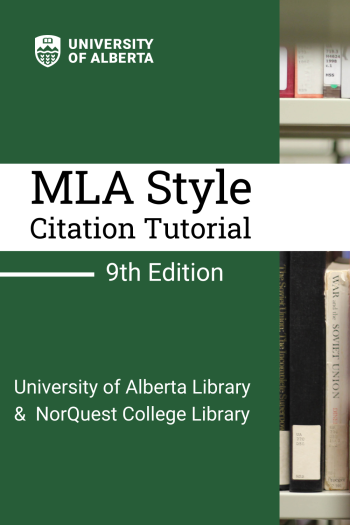 MLA Style Citation Tutorial
by
Authors: Sarah Bailey; Kara Blizzard; and Doris Wagner
MLA Style Citation Tutorial
by
Authors: Sarah Bailey; Kara Blizzard; and Doris Wagner
Containers hold multiple items. In the case of MLA, creative works are the pieces (articles, poems, songs, episodes, chapters, or posts) held by containers (databases, books, albums, series, anthologies, or websites).
If you find a source of information on or in a large collection or body of work, that collection is the container.
 Welcome to the MLA 9 Research Guide!
Welcome to the MLA 9 Research Guide!Modern Language Association (MLA) Style is commonly used in Humanities courses, such as English, for citing references in papers.
There are 2 parts to documentation in MLA Style:
Things to note about Core Elements of the Works Cited:
The Author element lists the primary creator of the work you are citing. The general format for the Author element:
Last Name, First Name, Middle Initial.
Example:
Scully, Dana.
*The general format for a source with two authors: Last Name, First Name, and First Name Last Name.
Scully, Dana, and Fox Mulder.
*The general format for a source with three or more authors: Last Name, First Name Initial., et al.
Scully, Dana, et. al
The Author element can be:
| author | editor | translator | creator | performer |
| director | illustrator | organization | corporate author | pseudonym |
The Title of Source element lists the title of the work you are citing. The general format for the Title of source element:
Example:
Concussion.
or
"Spring, Mountain, Sea." contained in The Secrets of a Fire King.
The Title of source element can be:
| book | article | collection | essay | story |
| poem | play | television series | television episode | website |
| song | description | tweet | email subject |
A container is a work that contains another work (for example, a journal is the container of an article). The general format for the Title of container element:
Title: Subtitle,
Example:
The Secrets of a Fire King, containing "Spring, Mountain, Sea."
or
Academic Search Complete, containing AlterNative: An International Journal of Indigenous Peoples, containing "It's in Our Blood."
The Title of container element can be:
| book | collection | journal | magazine | newspaper |
| periodical | play | television series | website | comic book series |
| digital database | streaming media provider | online network | digital platform |
A contributor are people, groups, or organizations that contribute to a work without being the primary author. The general format for the Other contributors element:
contributed by First Name Last Name,
Example:
edited by John W. Chalmers, et al.,
or
Created by I. Marlene King,
The Other contributors element can be:
| editors | translators | creators | adaptors | illustrators |
| narrators | performers | directors |
The general format for the Version element:
xxth Canadian ed., (ed.=edition)
Example:
2nd ed.,
or
version 1.2.1,
If the source includes a note indicating that it is a version or edition of the work, include it in your entry. The Version element can be:
| edition | version | other notation |
If the source you are citing is part of a sequence, such as a numbered volume or issue, then we will also include this number. The general format for the Number element:
vol. xx, no. xx, (vol.=volume; no.=number)
Example:
vol. 11, no. 2,
or
season 4, episode 9,
The Number element can be:
| volume | issue number | season | episode | division number |
The publisher is responsible for making the source available. The general format for the Publisher element:
Producer of Source, (city of publication is omitted unless it is pre-1900)
Example:
Oxford UP, (UP=University Press)
or
Quat'sous Films / Wild Bunch,
The Publisher element can be:
| publisher | producer | distributor | organization | institution |
| blog network | division of company |
The publication date lets the reader know when the version of the source you are citing was published. The general format for the Publication date element:
xx Mon. YEAR, xx:xx a.m./p.m.,
Example:
19 May 2016, 1:55 p.m.,
or
May-Jun. 2016,
The Publication date element can be:
| year | month/year | day/month/year | day/month/year, time |
The location of a source depends on its format. The general format for the Location element:
pp. xxx-xxx. or www.xxxx. or doi:xx.xxxx. or place.
Example:
pp. 29-30.
or
youtu.be/upsZZ2s3xv8. (URL/web address without http://)
or
Chateau Lacombe Hotel, Edmonton. (live presentation or a physical object seen in person)
The Location element can be:
| page number | range of page numbers | URL | DOI | disc number |
| place and city | city | archive number | venue and city |
 This work is licensed under a Creative Commons Attribution-NonCommercial 4.0 International License.
This work is licensed under a Creative Commons Attribution-NonCommercial 4.0 International License.